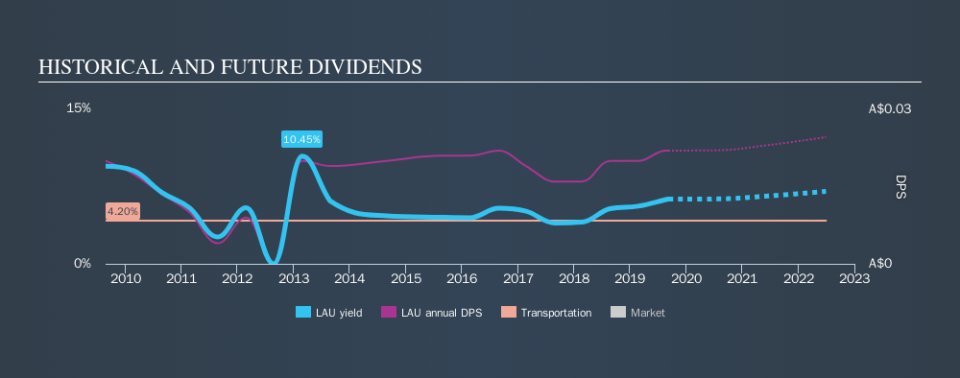4 Days Left Until Lindsay Australia Limited (ASX:LAU) Trades Ex-Dividend

It looks like Lindsay Australia Limited (ASX:LAU) is about to go ex-dividend in the next 4 days. You will need to purchase shares before the 12th of September to receive the dividend, which will be paid on the 30th of September.
Lindsay Australia's next dividend payment will be AU$0.011 per share, and in the last 12 months, the company paid a total of AU$0.022 per share. Based on the last year's worth of payments, Lindsay Australia has a trailing yield of 6.3% on the current stock price of A$0.35. If you buy this business for its dividend, you should have an idea of whether Lindsay Australia's dividend is reliable and sustainable. So we need to check whether the dividend payments are covered, and if earnings are growing.
Check out our latest analysis for Lindsay Australia
Dividends are typically paid out of company income, so if a company pays out more than it earned, its dividend is usually at a higher risk of being cut. Lindsay Australia paid out 70% of its earnings to investors last year, a normal payout level for most businesses. Yet cash flow is typically more important than profit for assessing dividend sustainability, so we should always check if the company generated enough cash to afford its dividend. Luckily it paid out just 16% of its free cash flow last year.
It's encouraging to see that the dividend is covered by both profit and cash flow. This generally suggests the dividend is sustainable, as long as earnings don't drop precipitously.
Click here to see the company's payout ratio, plus analyst estimates of its future dividends.
Have Earnings And Dividends Been Growing?
Companies that aren't growing their earnings can still be valuable, but it is even more important to assess the sustainability of the dividend if it looks like the company will struggle to grow. Investors love dividends, so if earnings fall and the dividend is reduced, expect a stock to be sold off heavily at the same time. With that in mind, we're not enthused to see that Lindsay Australia's earnings per share have remained effectively flat over the past five years. We'd take that over an earnings decline any day, but in the long run, the best dividend stocks all grow their earnings per share. Earnings per share growth has been slim, and the company is already paying out a majority of its earnings. While there is some room to both increase the payout ratio and reinvest in the business, generally the higher a payout ratio goes, the lower a company's prospects for future growth.
The main way most investors will assess a company's dividend prospects is by checking the historical rate of dividend growth. Since the start of our data, 10 years ago, Lindsay Australia has lifted its dividend by approximately 1.0% a year on average.
The Bottom Line
Should investors buy Lindsay Australia for the upcoming dividend? It's unfortunate that earnings per share have not grown, and we'd note that Lindsay Australia is paying out lower percentage of its cashflow than its profit, but overall the dividend looks well covered by earnings. Overall we're not hugely bearish on the stock, but there are likely better dividend investments out there.
Wondering what the future holds for Lindsay Australia? See what the two analysts we track are forecasting, with this visualisation of its historical and future estimated earnings and cash flow
We wouldn't recommend just buying the first dividend stock you see, though. Here's a list of interesting dividend stocks with a greater than 2% yield and an upcoming dividend.
We aim to bring you long-term focused research analysis driven by fundamental data. Note that our analysis may not factor in the latest price-sensitive company announcements or qualitative material.
If you spot an error that warrants correction, please contact the editor at editorial-team@simplywallst.com. This article by Simply Wall St is general in nature. It does not constitute a recommendation to buy or sell any stock, and does not take account of your objectives, or your financial situation. Simply Wall St has no position in the stocks mentioned. Thank you for reading.

